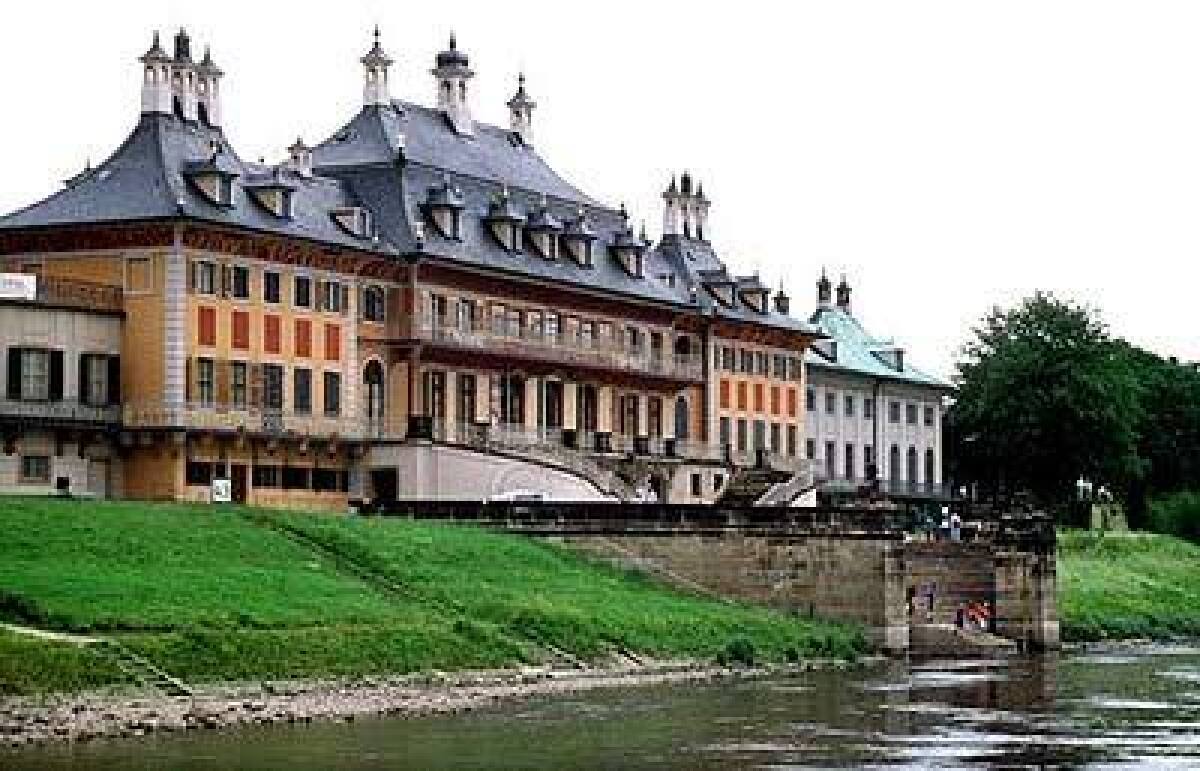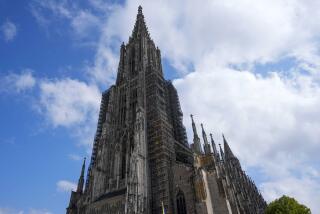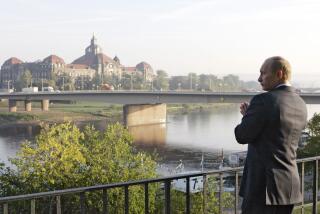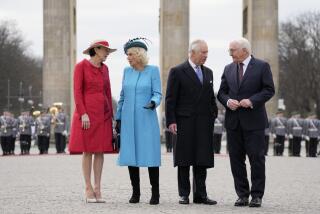Dresden’s spirit soars once more

You can’t get lost in Dresden. Wherever you go, you can see the stately white dome of the Frauenkirche, as much a landmark in this eastern German city as St. Peter’s is in Rome.
It isn’t just that the church towers 300 feet above Dresden’s lovely Baroque skyline, that its colossal dome was an architectural marvel when consecrated in 1734 or that it stood for religious tolerance in a Protestant city ruled by the Catholic electors of Saxony. Even its extraordinary acoustics, which inspired composer Richard Wagner, don’t fully explain its profound meaning to Dresden and the world.
Its significance stems from its destruction in the waning days of World War II. The Allied firestorm, dropped from the sky the night of Feb. 13, 1945, incinerated up to 80% of the city and killed 25,000 and maybe more. (Casualty figures vary because of the many refugees passing through the city at the time.) The Frauenkirche, or Church of Our Lady, continued to stand above the burning pyre until, structurally undermined, it collapsed without warning the morning of Feb. 15.
For the next 50 years, it lay in rubble on the city’s historic marketplace, a symbol of the devastation of war.
Now it has risen again, rebuilt of bits and pieces salvaged from the ruins, in an 11-year, $175-million project funded largely by international donations. From America came almost $3 million, raised by Günter Blobel, a 1999 Nobel laureate for medicine who donated nearly $1 million in prize money to the project. As an 8 1/2 -year-old war refugee, he passed through Dresden when it was intact. “For a child,” he said of the Dresden of that day, “it was like a fantasy.”
The completion of the Frauenkirche’s exterior this summer was marked by the placement of a golden cross and orb atop the cupola, a replica of the 18th century original. It was made by British silversmith Alan Smith, whose father flew a bomber to Dresden that night in 1945.
The interior is scheduled to be finished late next year, just in time for the 800th birthday celebration of the southeastern German city in 2006.
Dresden as it used to be
To prepare for the event, museums, gardens, squares, palaces, the railway station and whole city blocks are being renovated — leaving, for now, little unmarked by the unlovely signs of construction.When the scaffolding finally comes down, it won’t be hard to imagine what Dresden was before World War II: cultivated, pleasure-loving, one of Europe’s most cherished “grand tour” cities, filled with Italian Masters and rare Oriental porcelain, the architectural apogee of the German Baroque.
I came to Dresden last month seeking this reincarnated city and, more generally, the lost, urbane world of Eastern Europe that faintly whispers in such places as Krakow, Poland, and Riga, Latvia. I flew from Paris to Berlin, then drove south through the lush heartland of Saxony, close to the Polish and Czech borders. The carefully husbanded fields were bursting with sunflowers and bore no trace of the horrors of war.
Dresdeners understandably want to put World War II and the mean, dull years under communism behind them. I could not, because both are so much a part of the city’s remarkable story. I took two books with me: Frederick Taylor’s recently published “Dresden: Tuesday, February 13, 1945,” which contradicts a rising tide of opinion about the needlessness and immorality of Dresden’s destruction, and “Slaughterhouse-Five,” Kurt Vonnegut’s 1969 novel in which the time-traveling protagonist keeps getting shunted back to the Dresden of 1945.
Christoph Munch, a spokesman for the Dresden Tourist Promotion Board, labors to correct the misconception that the city is a pile of rubble interspersed with Soviet-era apartment blocks. “When I go to America,” he told me, “people say it must be terrible to live in Dresden.”
Terrible isn’t a word I’d use to describe it now.
Driving in, I saw it from afar, on an easy bend of the Elbe River, all salt-and-pepper-colored sandstone and Baroque whirligigs that look more like millinery than architecture. The old part of the city, or Altstadt, sits high above the river on a graceful terrace that 18th century playwright Johann Wolfgang von Goethe called the “balcony of Europe.”
With its forested ridges, castles and vineyards, the Elbe Valley has just been named a UNESCO World Heritage Site. Even in the heart of the city, the river retains its bucolic character, with more meadowlands at its flanks than stone embankments. I spied people in the middle of town, pitching tents, sunbathing and pushing kayaks into the current.
With no skyscrapers and a population of just half a million, Dresden is an open, airy city, easy to navigate. Signs directed me to the Kempinski Hotel Taschenbergpalais, another handsomely renovated Baroque landmark, pale yellow and trimmed with ornate white molding, occupying a city block and enclosing a courtyard. My elegant chamber on the northeast corner had a view of the Frauenkirche and a ceiling higher than the room was wide.
The Taschenbergpalais was built in 1705, conveniently close to the royal palace, for Countess Anna Constantia von Cosel, the mistress of Augustus the Strong. Modeling himself on Louis XIV of France, he ruled Saxony with flourish from 1694 to 1733 and eventually became king of Poland.
It was Augustus the Strong and his son Augustus III (1696-1763), both passionate builders and collectors, who gave Dresden its great Baroque art and architecture. To better understand the style, which many contemporaries consider over the top, even vulgar, I visited the Zwinger, a large, rectangular pleasure ground enclosed by galleries, towers and gates west of Taschenbergpalais.
To walk through the Zwinger is to feel your spirits rise. Nearly everywhere you look, from the gold-gilded Crown Gate on the southwest side to the adjacent Rampart Pavilion, with its twin curving staircases, there is elaboration. Naked stone satyrs, putti and nymphs wreathe its archways, gaze down from the balustrades of the upper terrace and congregate around the pool and fountain, blissfully unashamed to bare their generous breasts and behinds.
The buildings around the courtyard are occupied by three of the 12 museums that make up Dresden’s seemingly boundless State Art Collections, a great part of it amassed by Augustus the Strong and Augustus III.
That afternoon I visited the Zwinger’s Porcelain Museum. It’s a natural in a city known for fine white pottery like that made in China but not fabricated in Europe until 1706 when an alchemist working for Augustus the Strong set up a secret workshop in nearby Meissen. Together with Oriental objets d’art acquired by the porcelain-mad elector, notable examples of Meissen china, as it came to be called, are displayed in the museum, including a zoo of almost life-size animals: peacocks, sheep, foxes, lions and tigers.
Then it was on to perhaps the city’s most renowned museum, the Old Masters Picture Gallery, at the north corner of the Zwinger, with paintings chockablock on the walls. People naturally gravitate to Raphael’s “Sistine Madonna,” with its much-reproduced putti gazing up at Mary and Jesus. But every room holds amazements: Canaletto’s detailed Dresden cityscapes, massive Tintorettos and Veroneses on biblical themes, Rembrandt’s beguiling “Saskia With a Red Flower.”
I had dinner at Alte Meister, a sophisticated restaurant adjacent to the museum. Forget sauerbraten and strudel. I ordered cold, clear consommé, topped with bits of tomato, and baby free-range chicken in a sauce of chanterelles, accompanied by a glass of crisp German Chardonnay.
Views of the city
For the next few days, I roamed around Dresden, climbing the tower of the Kreuzkirche, or Church of the Holy Cross, to view the old town from on high, with the Elbe River separating it from the new town to the north. From this perch I could see the suburbs, some of which were leveled by World War II bombing and soullessly rebuilt during the Soviet era, others still gracefully Victorian, with wide, tree-lined boulevards.The huge Grosser Garten, with its zoo and botanical garden, spread southeast of the city center and about half a mile south lay the Hauptbahnhof, or main railway station. It is being rebuilt in a way that will conserve early 20th century elements and introduce high-tech new ones, such as a fabric roof.
Tourists spend most of their time in the Baroque Altstadt, north of the Frauenkirche and market square. It’s a small place, easy to appreciate in a casual stroll, with a short but lively restaurant row on Munzgasse Street, yielding directly to delightful Bruhle Terrace above the Elbe. There Dresdeners sprawl, sleeping on the grass like women along the Seine in Impressionist paintings, and street musicians hold forth. I gave a euro to a girl in a pinafore for a few strains of Palestrina.
On its west side, the terrace descends in a grand flight of steps to Palace Square, bounded by the towering facade of the Hofkirche, and the Geor- genbau gate. The royal palace, an architectural mélange dating from 1530, has been under renovation since 1990 but is scheduled to be completed for 2006. For now you can enter its stables, lined by handsome white Tuscan arches and the occasional rack of antlers; outside, a porcelain tile mural depicts more than 100 members of the Saxon royal house. You can also peek at the royal precincts through a break in the walls on Schlossstrasse or visit the three Dresden State Art Collections inside: the armory; the print, drawing and photography museum; and, soon, Augustus the Strong’s priceless Green Vault, the royal treasury.
I got a tour of the treasury museum in the making from Director Dirk Syndram, who said Augustus the Strong put his riches on display to impress his subjects and assure his son’s succession to the Polish throne. In September, half of the Green Vault will open, with 16th century silver caskets, ivory frigates, jewel-encrusted nautilus shells and a show-stopping gold, diamond and enamel miniature replica of India’s court of Grand Mogul. In 2006, more incredible gewgaws, including a storied 41-carat green diamond, will go on display.
It is just such a diamond I should have been wearing when I went one night to see the Alvin Ailey American Dance Theater at the Semper Opera, beside the royal palace and Zwinger on Theater Square. It was designed by Gottfried Semper and opened in 1841. It is pale green inside, with delicate molding, like a cameo, and a magnificent Baroque drop in front of the proscenium.
I also listened to classical music. One night I went to the Frauenkirche to hear the Epoca Barocca quartet play Handel, Corelli and Vivaldi. The concert was in the newly completed undercroft, but when I entered I got a glimpse of the inside of the church — a lofty space where, on several occasions, Johann Sebastian Bach played the organ.
On Sunday morning, I went to a service at the Roman Catholic Hofkirche, chiefly to hear hymns played on the booming organ made, like the one at the Frauenkirche, by 18th century master Gottfried Silbermann. The Saxon electors’ basilica has a soaring, slender spire almost as tall as that of the Frauenkirche, a massive altarpiece of Christ’s ascension by Anton Raphael Mengs and an ornate Baroque pulpit.
A castle cruise
There was time to take a river cruise on the spit-and-polish 1929 steamship Leipzig, east past three romantic villas perched high above the Elbe in the suburb of Loschwitz, then under the Blue Wonder, a filigreed steel suspension bridge built about the same time as the Eiffel Tower. My destination was Pillnitz Castle, the summer residence of the Saxon electors, designed by Matthäus Daniel Pöppelmann for Augustus the Strong, who traveled there by gondola. Three wings border a formal garden, two of them tangerine-colored with chinoiserie gables, lantern-shaped chimneys and Chinese friezes on the facades. The surrounding park is lush and well tended, shaded by mature copper beech, elm and pine trees.One day I drove to Moritzburg Castle, the hunting lodge of Augustus the Strong. It’s on an artificial island in a lake about 30 minutes northwest of town. It’s imposing but kitschy, decorated inside with several herds worth of antlers. Even in the formal banqueting hall they line the walls floor to ceiling.
There is little in tourist Dresden to recall the catastrophe of 1945, but I felt compelled to seek out a reminder, so on the way back from Moritzburg Castle, I stopped in nearby Heidefriedhof cemetery, where the ashes of thousands who died in the firestorm were buried in mass graves. It’s a strange, somber place without crosses and angels, just plots in a pine forest.
Confused, I found two attendants and tried to ask whether there was a World War II memorial in the cemetery. They spoke only German but directed me down a tree-lined path. At the end, I found a stone circle surrounded by the names of World War II disaster sites, including Dresden.
The Luftwaffe poured hellfire over England during World War II. Taylor’s “Dresden” reports that in spring 1942, Germany sent bombers to Exeter, Canterbury, Norwich and York. Their orders — as Nazi spokesman Baron Gustav Braun von Stum is said to have told the press — were to destroy “every building in England marked with three stars in the Baedeker Guide.” The Allies reciprocated, wasting one German city after another. All the while, Dresden remained untouched, too beautiful and historic to target, people thought, until that winter night just months before the end of the war.
It’s frivolous, perhaps, to rue the destruction of tourist sites in the same breath as the human casualties of war. But to lose a Frauenkirche is to lose history, art and culture that cannot easily be recovered. In Dresden, they have been, which makes the city doubly precious.
*
(BEGIN TEXT OF INFOBOX)
Baroque landscape
GETTING THERE:
From LAX, Lufthansa and Air Canada offer connecting flights (change of plane) to Dresden. Restricted round-trip fares begin at $940.
I flew to Berlin and rented a car. It’s about a two-hour drive, the same as by train. Lufthansa, Air France, KLM, British and Swiss offer connecting flights to Berlin. Restricted round-trip fares begin at $940.
TELEPHONES:
To call the numbers below from the U.S., dial 011 (the international dialing code), 49 (country code for Germany) and the local number.
WHERE TO STAY:
Kempinski Hotel Taschenbergpalais Dresden, Taschenberg 3, 01067, Dresden; 351-49120, https://www.kempinski-dresden.de , is one of the premier hotels in the city center in the renovated palace of Countess Cosel, the mistress of August the Strong. Doubles begin at $350.
Hotel Bülow Residenz, Rähnitzgasse 19, 01097, Dresden; 351-80030, https://www.buelow-residenz.de , is a small, elegant hotel just across the Elbe River from the city center, part of the Relais & Châteaux group. Doubles $270.
Hilton Dresden, An der Frauenkirche 5, 01067, Dresden; 351-86420, https://www.dresden.hilton.com , enjoys the best location of any hotel in the city, right across the street from the rebuilt Frauenkirche. It’s a modern building with contemporary décor, several restaurants and a health club. Doubles, $140, though Hilton special rates and packages are sometimes available.
WHERE TO EAT:
Caroussel, Hotel Bülow Residenz (see above) is a formal restaurant with pitch-perfect service and a sophisticated French-German menu. A four-course dinner, without wine, costs $93.
Italienisches Dörfchen, 3 Theaterplatz, 351-498160, is a historic building on theater square, overlooking the Elbe River, with six restaurants, including a beer garden. Casual to elegant.
Alte Meister, Theaterplatz 1A, 351-4810426, is a pretty cafe restaurant with umbrella tables, just outside the Old Masters Picture Gallery in the Zwinger. Two-course dinner, with a glass of wine, about $36.
TO LEARN MORE:
Dresden Tourist Information, Schinkelwache/Theater Square, P.O. Box 120952, 01010, Dresden; 351-491920 https://www.dresden-tourist.de .
German National Tourist Office, (800) 651-7010, https://www.cometogermany.com .
— Susan Spano
More to Read
Sign up for The Wild
We’ll help you find the best places to hike, bike and run, as well as the perfect silent spots for meditation and yoga.
You may occasionally receive promotional content from the Los Angeles Times.






